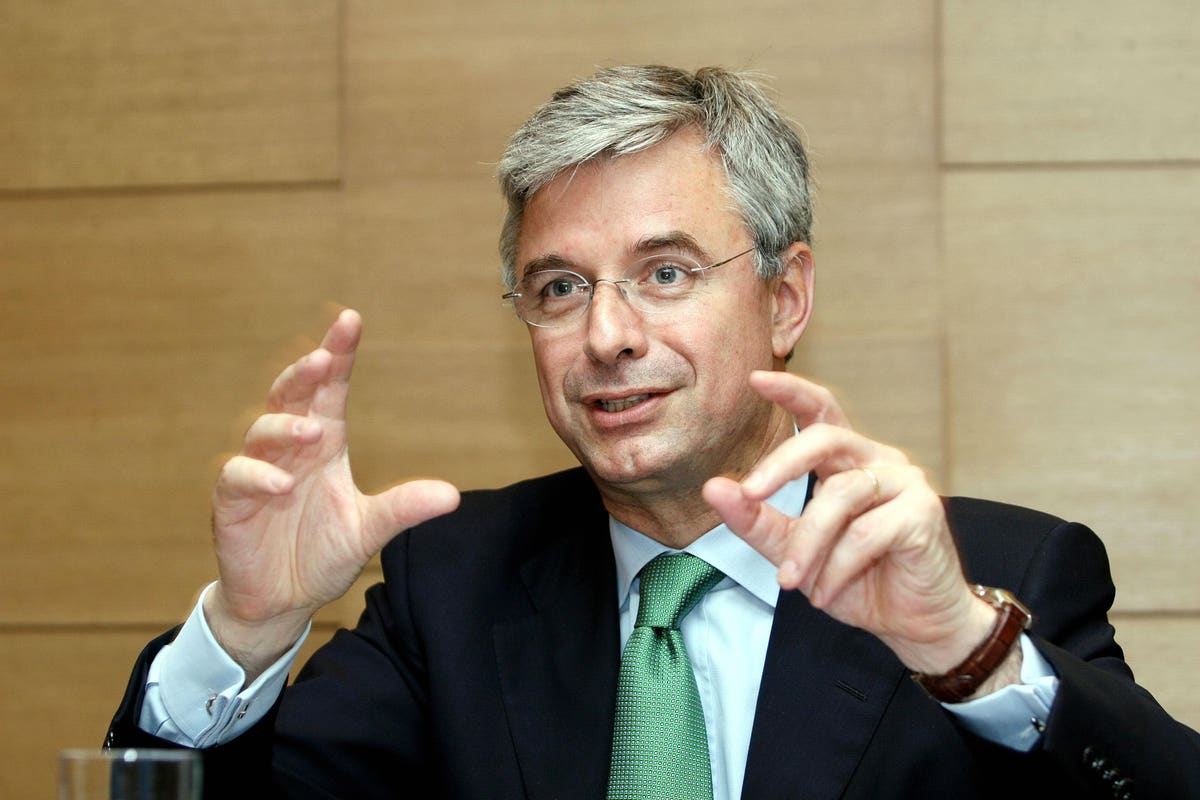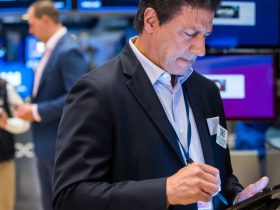Hubert Joly has enjoyed an amazing career journey — made famous by his tenure as Best Buy’s CEO from 2012 to 2019.
That’s when he took the electronics retailer from losing billions to earning a 3% net profit margin — contributing to a 330% rise in its stock price (about three times faster than the S&P 500’s growth).
On August 29, Best Buy reported better-than-expected second quarter results under the leadership of Corie Barry, his hand-picked successor.
The same day, Joly — now a senior lecturer at Harvard Business School — told me what distinguishes leaders who can preside over sustainable growth and why he chose Barry as CEO.
His principles of leading sustainable growth made me think investors ought to seek out CEOs who:
- Adapt effectively to rapidly changing industry headwinds and tailwinds
- “Refound” — Joly’s term for bringing back to growth — after a company hits the doldrums
- Lead with humility and intellectual curiosity
- Develop a successor by testing their ability to tackle ever-harder challenges
- Capture short- and longer-term growth opportunities
Best Buy’s Expectations-Beating Second Quarter Results
Best Buy beat investor expectations for its second quarter financial results — sending its shares up 3% between the day before its earnings report and August 31.
That does not mean Best Buy is growing. Consumers are now spending on experiences rather than aggressively buying electronics equipment as they did the year before — contributing to a decline in the company’s top line and a trimming of its revenue forecast for the year.
Here are the key numbers, according to CNBC:
- Q2 revenue: down 7% from the year before to $9.58 billion — $60 million ahead of consensus, according to Refinitiv.
- Q2 adjusted earnings per share: $1.22 — 16 cents more than expected according to Refinitiv.
- Q2 net income: $274 million — 10% lower than the year before.
- Fully year revenue forecast (midpoint of range): $44.15 billion — $350 million lower than the midpoint of its previous forecast.
Falling demand for appliances, home theater, computing and mobile phones was partially offset “persistent growth” in the company’s gaming categories, CNBC noted.
Barry told the Wall Street Journal, “Our financial results were better than expected, and they reflect a consumer electronics industry that remains challenged due to the pull-forward of demand in prior years and the various macroeconomic factors that we are all too familiar with. We continue to expect that this year will be the low point in tech demand after two years of sales declines.”
Best Buy told investors things are looking better. In the CNBC report, CFO
CFO
How Joly Turned Around Best Buy
Joly took over Best Buy at a low point and left it in good shape for Barry when she became CEO in June 2019 — not long before Covid-19 turned the world upside down.
As I wrote in December 2019, Joly — who had previously run hospitality company Carlson — took over as Best Buy’s CEO in August 2012. The move followed a whopping $1.7 billion loss and the departure of its previous CEO in the wake of his “close relationship” with a female employee, Bloomberg reported.
By June 2019 when Joly handed over Best Buy’s reins to Barry, the retailer’s shares had soared 330% from $20 to about $68. The S&P 500 rose 111% during the period, and in the quarter ending May 2019, the company had earned a 3% net profit margin.
To turn around Best Buy, Joly did eight things:
- Created meaning for employees. While his predecessor saw employees as costs to be minimized — for example, he eliminated employee discounts — Joly created meaning for them. As Joly told Twin Cities Business, “I believe the purpose of a company is to contribute to the common good: its customers, its employees, and the community in which it operates. If you can connect the search for meaning of the individual with the purpose of the company, then magical things happen.” To that end, Joly encouraged store managers to ask employees what their dreams were. One worker in a store outside Boston said he wanted to buy a home. His manager created a career plan to help the worker move up so he could afford one.
- Got customers to try, then buy. Joly began his Best Buy tenure by spending a week with associates in a St. Cloud, Minn. store. They told him about showrooming – customers who visited the store, talked to Best Buy employees and bought from an online purveyor like Amazon
AMZN
- Made it easier for customers to order and pick up their goods at the store. Best Buy’s new system enabled consumers to order online and retrieve their items within an hour — and 70% of the U.S. population lived within 15 minutes of a Best Buy location.
- Created a mission for store associates. He articulated a clear role for team members: “to be trusted advisors who help customers evaluate and choose new technology,” according to HEC Stories.
- Widened its selection of popular merchandise. In April 2018, Best Buy inked a deal with Amazon to retail exclusively its Fire TV Edition smart TVs. Joly concluded the benefits to Best Buy – including Amazon’s investment in the Best Buy stores and the popularity of its product with customers – outweighed the costs of helping its rival.
- Cut costs that did not add to the customer experience. Joly aimed to eliminate spending by making its processes more efficient. Out of $2 billion, about 80% of the costs Best Buy reduced came from non-salary expenses. For example, Best Buy saved $200 million by working with suppliers to design and ship TVs in a way that would keep them from breaking before they arrived at a customer’s house, according to CNBC.
- Make the website easier for customers to use. Associate feedback persuaded Joly to invest in a faster, easy-to-search website and to restore the employee discounts his predecessor had eliminated. These moves helped Best Buy reduce worker turnover from 50% in his first few years to 30% by 2018.
- Shed non-core people and assets. Finally, Joly did aggressive cost cutting. The company cut about 2,000 middle managers in early 2014, selectively closed some 50 stores between 2014 and 2018; exited a European retail joint venture in 2013; sold off its stores in China in 2014; and in 2018 killed its Best Buy Mobile business, closing the remaining 257 small standalone stores, according to TCB.
Joly’s turnaround put Best Buy in a strong position for Barry.
Sustaining Growth And Why Joly Picked Barry As CEO
Joly has remained active on company boards and leads senior executive programs. After Barry became CEO, Joly remained Best Buy’s Executive Chair until 2021 and joined the board of Johnson & Johnson
JNJ
Resilience Is Critical For Sustaining Growth In The Face Of Crisis
He told me sustainable growth comes, in part from a leader’s resilience. Here’s his definition from our August 29 interview: “Resilience is withstanding a shock or responding or adapting to a new environment. Resilience can be present for an individual, a team, an organization, or society. For organizations, resilience is about how to adapt to a new environment.”
Resilience is particularly important now as the world seems to be in a permanent state of crisis. There are many daunting shocks leaders must face such as climate change, the end of happy globalization, geopolitical tension, the societal divide, social inequity, generative AI, inflation, and the “recession that never comes,” he said.
To refound their companies, CEOs must revisit their core beliefs, set goals and develop habits. “This is what happened when Satya Nadella took over as Microsoft CEO from Steve Ballmer,” Joly explained. “Nadella updated Microsoft’s purpose — from a PC on every desk to helping everyone accomplish more and embed mobile and cloud-first. Nadella has a growth mindset and he created a culture of empathy: of meeting unmet and un-articulated customer needs.”
What Joly Stepped Into When He Became Best Buy’s CEO In 2012
Dick Schulze served as Best Buy’s CEO from 1983 to 2002. Schulze founded and was CEO of Sound of Music Stores, a stereo equipment retailer. Joly told me two stories about how Schulze refounded the company.
In June 1981, a tornado in St. Paul ripped off the roof of the store. There was water damage. He put everything — turntables, receivers and speakers — on sale stacked on wooden pallets in the parking lot. Consumers wanted to see the tornado damage — and to get the “best buy.” This led him to change the company’s name to Best Buy, Joly said.
Six years later, Schulze got rid of commissions. He viewed them as “a toxic incentive from vendors.” Schulze replaced them with “sales people wearing blue shirts who were non-commissioned and customer-centric,” Joly told me.
When he became CEO in 2012, Best Buy had gone sideways. “The company had become complacent and needed a new purpose, strategy, and culture,” Joly said. “You need to replace it with intellectual humility and curiosity. When I became CEO, I knew nothing about retail. I was humble. I asked questions in the stores. Not knowing anything was a huge advantage.”
Choosing Barry As His Successor
Barry did every job he asked her to do much better than Joly said he could have done it. “Corie is doing a fabulous job,” he said. “She had worked at Best Buy for 20 years and was promoted at age 43 to CFO.”
“I was impressed by the slope of her development,” he added. “Every time I gave her a more challenging assignment, she would knock it out of the park. She asked me, ‘Why are you asking me to do this?.’ I told her, ‘Because you could do it.’ ”
Joly explained how she also was willing to take risks: “How does a tortoise move forward? It sticks its next out. I gave her stretch assignments and she knocked them out of the park. Ultimately, [the decision to make her CEO came down to] character, learning agility, curiosity, humility, and how the individual has dealt with stretch assignments.”
Investing In Growth Opportunities
Leaders must invest in growth opportunities that work in the short- and longer-terms. To find opportunities for short-term improvement, he said, “Asking people on the front lines is always a good idea. You find out what’s broken and identify near-sight opportunities.”
To get blue ocean ideas — new, uncontested growth opportunities — requires an eagerness to learn — which Barry did when Covid-19 hit. “Nobody knew what to do,” Joly explained. “Corie spoke with other CEOs and worked with our team. Admit you don’t know. Instead of being a know it all, be a learn it all. I joke when I introduce myself: ‘My name is Hubert and I don’t know.’ People confuse perfection with performance. Companies need leaders who can be vulnerable.”
To refound a company, leaders must find a compelling shared purpose — which becomes the brand’s north star and a great filter for new ideas. Best Buy defined its purpose as “enriching lives with technology by addressing key human needs,” he said.
Best Buy encouraged ideas from many places and came up with hundreds of them. Joly picked investment ideas that passed the following tests:
- The world needs it.
- Best Buy is uniquely good at delivering it.
- Best Buy is passionate about it.
- Best Buy can make money at it.
These principles can also help investors identify companies likely to sustain growth.
Read the full article here













Leave a Reply